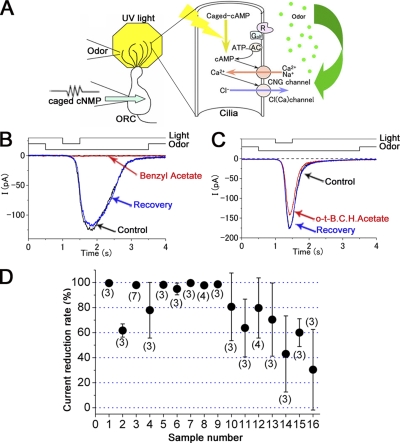Figure 1.
Odorant suppression of cAMP-induced current in single ORCs. (A) Schema of experimental procedure and biochemical reactions in the olfactory cilia. Photolysis of caged cAMP induces a current response with CNG and Cl(Ca) components after bypassing the olfactory enzymatic cascade. Simultaneously, odorous chemicals were puff-applied to the cilia to investigate the effect on the transduction channels. (B) Effect of 0.1% benzyl acetate on the cAMP-induced current. After the light-induced current was recorded as a control (black), benzyl acetate was applied before the light stimulation to cover the response period observed in the control (red). After a 20-s interval, the light stimulation was again applied in the absence of chemical (blue) to observe the recovery. Downward deflection of the upper traces indicates the timing and duration of the light and odor stimulation. Holding potential (Vh) = −50 mV. Light stimulation was 0.48, as a relative value in our setup (see Takeuchi and Kurahashi, 2002). (C) Effect of 0.1% o-t-B.C.H.acetate on the cAMP-induced current. After the control (black), o-t-B.C.H.acetate was applied before the light stimulation (red). After a 20-s interval, light stimulation was applied in the absence of chemical (blue). Vh- = −50 mV. (D) Channel blocking score of 16 samples (see also Table I). Zero indicates no effect. Error bars indicate SD. Numbers in parentheses indicate the numbers of cells examined.

